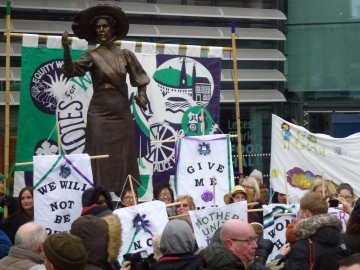Whose suffrage campaign story should we commemorate with a statue?

This enquiry encourages students to assess the significance of different campaigners for female suffrage through focusing on the creation of commemorative statues.
The enquiry begins by studying the new statues of Emmeline Pankhurst in Manchester and Alice Hawkins in Leicester to help students draw out the criteria for why people today might choose to put up statues of people from the past. Keeping these criteria in mind, students then study the contribution made by a variety of women to the campaign for female suffrage, through a series of case studies and the online database. In light of their criteria, students then reach their own judgment about whose suffrage campaign they wish to commemorate and design their own statue to do so.
Key learning points
- Arguments for and against giving women the vote in the nineteenth century
- The role played by the suffragettes, including Emmeline Pankhurst, and the suffragists in winning the vote for women
- Controversy surrounding the statue of Millicent Fawcett
- Stories of several individuals from the suffrage database and how they contributed to the female suffrage campaign
- Why people today choose to remember people in the past with statues
Scholarly rationale
This enquiry allows students to go beyond the more prominent figures in the suffrage campaign, like Emmeline Pankhurst and Millicent Fawcett, and study some lesser-known figures who also played an important part in the suffrage campaign. It is all too easy when telling the story of the suffrage campaign to focus on the leaders of the suffragists and suffragettes and miss out the thousands of other women who contributed to the campaign. Since the 1970s, feminist historians have been looking to uncover hidden histories from the suffrage campaign, and this enquiry similarly looks to remember these perhaps-unknown individuals, by giving students a chance to study the stories of individuals like Selina Cooper and Hannah Mitchell, whose contributions to the suffrage campaign have been brought to light by these historians.
Curricular rationale
Students to reach their own judgements about historical significance
This enquiry allows students to wrestle with the concept of historical significance as they judge for themselves whose suffrage campaign story they think deserves to be commemorated with a statue. By studying why the people of Manchester and Leicester have chosen to commemorate Emmeline Pankhurst and Alice Hawkins respectively, students will explore the criteria by which others have judged certain individuals to be historically significant and thus worthy of commemoration. Through looking at these very different choices, students will be encouraged to recognise how judgements of historical significance are influenced not only by the actions of those in the past, but also by those doing the remembering in the present as they look to connect with the past. This will allow students to assess the historical significance of suffrage campaigners based on a variety of criteria (e.g. achieving change, inspiring others, identifiable with a place or class), before choosing which criterion to prioritise as they decide on the suffrage campaign story they want to commemorate.
Giving students a chance to identify with individuals from the past
This enquiry makes use of the massive database of suffrage campaigners to encourage students to find the story of individuals from a similar place and background to them. Furthermore, the case studies of suffrage campaigners have been carefully chosen to represent a variety of classes and backgrounds, ranging from a princess of Indian heritage, to a well-educated, middle-class woman, to very poor, working-class women. It is hoped that this will make it possible for students to connect the history of their own community with that of the wider suffrage campaign, much like the communities of Manchester and Leicester have looked to do with their statues of Emmeline Pankhurst and Alice Hawkins respectively.
If you are downloading this unit to use with your students, why not think about taking part in the evaluation project which aims to examine the impact of this website and resources upon student knowledge and democratic engagement? Participation involves the administering of a student quiz both before and after the learning sequence. You can find details here.
- HA Suffrage Enquiry 3 - Teacher Notes
148.5 KB PDF document - HA Suffrage Enquiry 3 - Resources
1.78 MB PDF document - HA Suffrage Enquiry 3 - Lesson 1 PowerPoint
3.13 MB Powerpoint presentation - HA Suffrage Enquiry 3 - Lesson 2 PowerPoint
7.57 MB Powerpoint presentation - HA Suffrage Enquiry 3 - Lesson 3 PowerPoint
4.46 MB Powerpoint presentation - HA Suffrage Enquiry 3 - Lesson 4 PowerPoint
5.5 MB Powerpoint presentation - HA Suffrage Enquiry 3 - Lesson 5 PowerPoint
2.37 MB Powerpoint presentation
